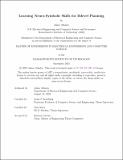Learning Neuro-Symbolic Skills for Bilevel Planning
Author(s)
Athalye, Ashay
DownloadThesis PDF (17.15Mb)
Advisor
Kaelbling, Leslie P.
Silver, Tom
Terms of use
Metadata
Show full item recordAbstract
It is challenging for robots to solve tasks in environments with continuous state and action spaces, long horizons, and sparse feedback. Hierarchical approaches such as task and motion planning (TAMP) address this challenge, enabling efficient problem solving by decomposing decision-making into two or more levels of abstraction. In a setting where expert demonstrations, symbolic predicates for state abstraction, and manually designed parameterized policies are given, prior work has shown how to learn symbolic operators and neural samplers for TAMP. But Manually designing parameterized policies can be difficult and impractical, so we would instead like our agent to learn them. In this work, we develop a method for learning parameterized polices in combination with operators and samplers from demonstrations. These components are packaged into modular neuro-symbolic skills and sequenced together with search-then-sample TAMP to solve new tasks. In experiments in four robotics domains, we show that our approach – bilevel planning with neuro-symbolic skills – can solve a wide range of tasks with varying initial states, objects, and goals, outperforming six baselines and ablations.
Date issued
2023-09Department
Massachusetts Institute of Technology. Department of Electrical Engineering and Computer SciencePublisher
Massachusetts Institute of Technology